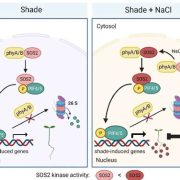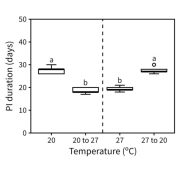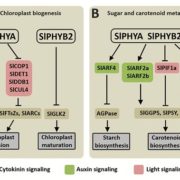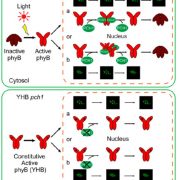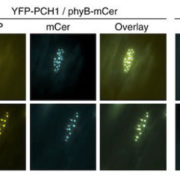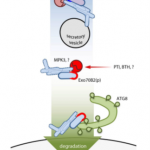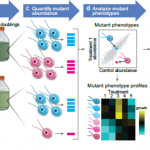Shade avoidance or shade tolerance? The balancing act of PIF-HFR1 module (EMBO J.)
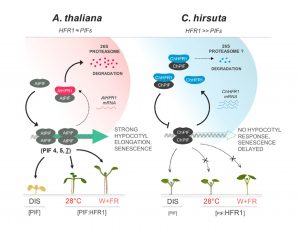 Plants have evolved two major adaptive strategies to tackle shade from their neighbours: avoidance and tolerance. However, what makes a species shade-avoider or shade-tolerant at the molecular level has remained mostly elusive. Recently, Paulisic et al. uncovered the key role of a regulatory module formed by PHYTOCHROME INTERACTING FACTORS (PIFs) and LONG HYPOCOTYL IN FR1 (HFR1) in orchestrating the two shade-adaptive strategies. They compared Arabidopsis thaliana and Cardamine hirsuta, two closely related plants that exhibit, respectively, shade avoidance and shade tolerance. Under shade, PIFs mediate hypocotyl elongation in Arabidopsis by transcriptionally regulating numerous downstream genes, whereas HFR1 controls this by interacting and interfering with PIFs. Being shade-tolerant, C. hirsuta displays no hypocotyl elongation under shade. Interestingly, HFR1 loss-of-function restored the shade-induced hypocotyl elongation in C. hirsuta. HFR1 from C. hirsuta (ChHFR1) was found to be remarkably more stable than AtHFR1 owing to a weaker interaction affinity with the E3 ubiquitin ligase CONSTITUTIVELY PHOTOMORPHOGENIC1 (COP1). Enhanced HFR1 level in C. hirsuta leads to an increased attenuation of PIF-function and therefore, a more powerful suppression of hypocotyl elongation. Together, this differential balance of PIF-HFR1 module drives the shade avoidance and shade tolerance traits. Additionally, thermomorphogenesis and dark-induced senescence are compromised in C. hirsuta, indicating a general antagonistic effect of HFR1 on major PIF-dependent processes across species. (Summary by Yadukrishnan Premachandran @yadukrishprem) EMBO J. 10.15252/embj.2019104273
Plants have evolved two major adaptive strategies to tackle shade from their neighbours: avoidance and tolerance. However, what makes a species shade-avoider or shade-tolerant at the molecular level has remained mostly elusive. Recently, Paulisic et al. uncovered the key role of a regulatory module formed by PHYTOCHROME INTERACTING FACTORS (PIFs) and LONG HYPOCOTYL IN FR1 (HFR1) in orchestrating the two shade-adaptive strategies. They compared Arabidopsis thaliana and Cardamine hirsuta, two closely related plants that exhibit, respectively, shade avoidance and shade tolerance. Under shade, PIFs mediate hypocotyl elongation in Arabidopsis by transcriptionally regulating numerous downstream genes, whereas HFR1 controls this by interacting and interfering with PIFs. Being shade-tolerant, C. hirsuta displays no hypocotyl elongation under shade. Interestingly, HFR1 loss-of-function restored the shade-induced hypocotyl elongation in C. hirsuta. HFR1 from C. hirsuta (ChHFR1) was found to be remarkably more stable than AtHFR1 owing to a weaker interaction affinity with the E3 ubiquitin ligase CONSTITUTIVELY PHOTOMORPHOGENIC1 (COP1). Enhanced HFR1 level in C. hirsuta leads to an increased attenuation of PIF-function and therefore, a more powerful suppression of hypocotyl elongation. Together, this differential balance of PIF-HFR1 module drives the shade avoidance and shade tolerance traits. Additionally, thermomorphogenesis and dark-induced senescence are compromised in C. hirsuta, indicating a general antagonistic effect of HFR1 on major PIF-dependent processes across species. (Summary by Yadukrishnan Premachandran @yadukrishprem) EMBO J. 10.15252/embj.2019104273


